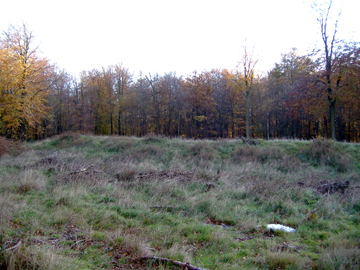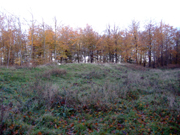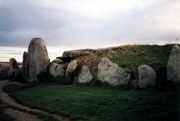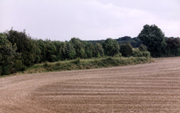
Return to Neolithic Burials Display
Display Contents
Neolithic Burials
Link - Longbarrows
What is a barrow
Houses of the dead
Earthen longbarrows
The end of longbarrows
Link - Longbarrows

Kings Wood Earthen longbarrow, Challock, Kent
A barrow is a monument built to house the remains of the dead. It generally comprises a focal structure or pit which contains the body (or bodies) and this is covered by a mound of earth. The earth is gained from the excavation of a ditch (or ditches) around the burial.

Kings Wood Earthen longbarrow, Challock, Kent
The Neolithic longbarrow echoed the form of the houses in which our Neolithic ancestors first lived.
Earthen longbarrows
These are the type of Earlier Neolithic burial monuments which we would expect to find on Thanet (should any have been built here). They were generally constructed in two distinct phases.
The first phase would have seen the
creation of a narrow, rectangular
burial chamber (generally between 2-6m long and 1m wide) formed by pits
or post-holes. This was probably the setting for a wooden, box-like
structure which may or may not have been roofed. An example at
Thickthorn Down in Dorset had a chamber built of turves (Lynch 1997).
The
burial chamber is the heart of the monument and would store the
disarticulated (ie.
jumbled) remains of a
Neolithic family or community's dead. Whether they initially
interred the bodies whole and then subsequently moved these
remains about to make room for new burials is not clear.

The excavation of some stone-built
chambered tombs (which had a much
longer life-span) have revealed that different chambers could be used
to store different body parts. It is thought that some pieces (such as
skulls and long-bones) could have been removed for use in ritual
practices, for example at Causewayed Enclosures.
Excavations at these large, likely
seasonal meeting-places have uncovered isolated bones and human
skulls which had been placed at the base of the ditches. It has been
noted that skulls and child burials occur less frequently or are
'missing' from chambered tombs, but are more common finds at Causewayed
Enclosures.
The burial chamber is usually surrounded
by a long, rectangular wooden fence (a close-set palisade - Lynch
1997). This boundary often defines the extent of the covering mound
which is erected during the later, final phase of construction. It is
normally orientated east-west (Lynch 1997).
The palisade usually has two straight
stretches which front either side of the burial chamber. The depth of
the
foundations sometimes suggest that the palisades may have been
particularly high
at this point.
It is thought that this process may have been viewed as allowing the spirit or soul of the dead person to be freed from the body
At some sites the presence of more
post-holes in front of this facade
suggest that another structure or 'mortuary house' may have been
constructed. Here the funery
rituals could have taken
place and perhaps the
dead bodies were exposed in the practice of excarnation,
prior to later burial. These structures are characteristic of Southern
British sites and are not a regular feature elsewhere in Britain (Lynch
1997).
In some cases the wooden structure would first be destroyed by fire and at Nutbane the mound was thrown over the smoldering embers (Darvill 1987; Lynch 1997).

Facade of the West Kennet Megalithic tomb, Wiltshire
These
wooden structures likely had a much shorter lifespan than the
Megalithic tombs. The chambers of the latter were made of huge stone
slabs and
could have remained accessable within the mound for generation after
generation.
While the longbarrows may have remained in use (in one form or another) for many years, it appears that no new monuments were being built in Southern England after 3000 BC (Lynch 1997).

Julieberrie's Grave
Earthen longbarrow, Chilham, Kent
In the Late Neolithic there was a profound cultural change in our ancestor's attitude to the disposal of their dead. There was a move away from the idea of communal burial and instead they began to build monuments that generally focused attention on a single individual and often included grave goods.
Many variations of these rites exist of
course, but the move to an emphasis on building round structures
(encompassing houses, Henges and barrows) in the Late Neolithic appears
to be a universal phenomena throughout Britain. The presence of some
multiple burials and the inclusion of additional disarticulated human
remains in both roundbarrow and flat-grave burials may hark back to
ancestral traditions of the Earlier Neolithic.
It has been suggested that late forms of
the longbarrow monument may show a more oval plan to the
barrows, or feature a ditch which begins to
encircling the
monument (taking on a ‘U’-shape), or see the inclusion of single
burials (or sometimes no burials at all). These features may
be seen as transitional between Neolithic traditions and the evolving roundbarrow rite. There is great variety
in longbarrow forms however and some have questioned whether these
characteristics can really be considered 'late'.
TSMR -
Thanet Sites and Monuments Record.
Ashbee P. 1966. The Fussell's Lodge Long Barrow Excavations, 1957. Archaeologia C.
Darvill T. 1987. Prehistoric
Lynch F. 1997. Megalithic Tombs and Long Barrows in Britain. Shire Publications Ltd.
Vyner B. 1984. The Excavation of a Neolithic Cairn at Street House , Loftus, Cleveland. Proceedings of the Prehistoric Society 50.
Some of the specific information on
longbarrows presented here has been taken
from Frances Lynch's excellent
book 'Megalithic Tombs and Long Barrows in Britain', published in 1997
by Shire Publications Ltd. Shire produce a
wide range of accessable and invaluable archaeological books (please
take a look at their website if you would like to learn more).
Version 2 - Posted 16.12.06
All
content © Trust for Thanet Archaeology